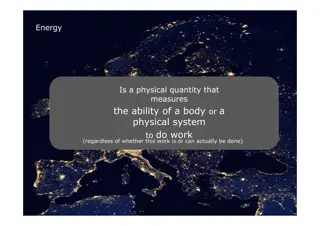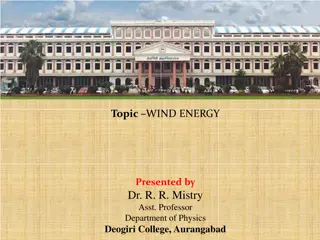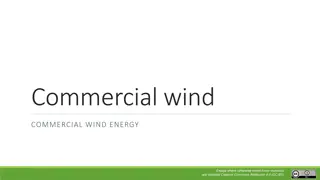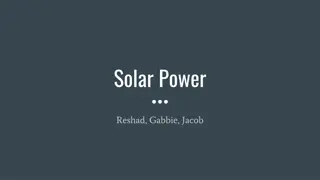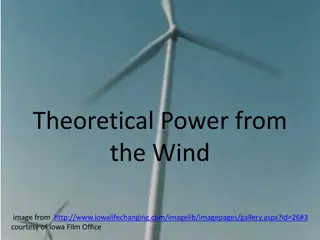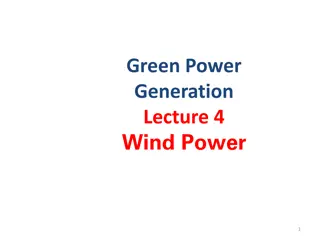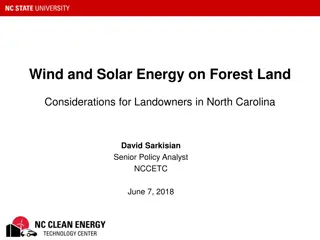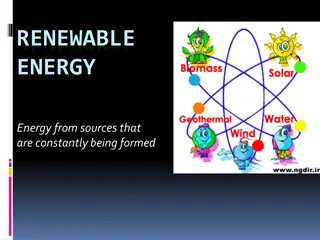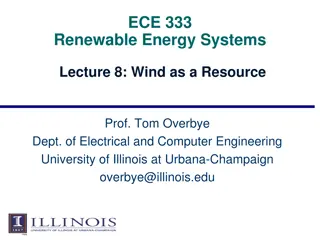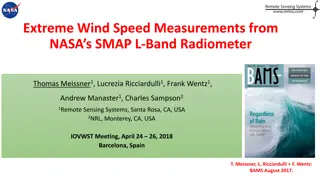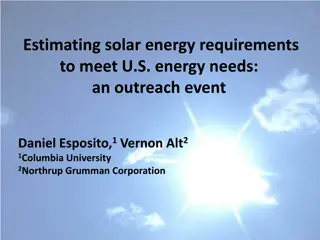
Energy Opportunities: Solar, Wind, and Efficiency Insights
This content delves into the economic considerations, policy recommendations, and conclusions for solar and wind energy, along with insights on household energy consumption in Appalachian states. The analysis includes details on solar energy's moderate resource status, wind energy developments, and recommendations for maintaining current policies.
Download Presentation

Please find below an Image/Link to download the presentation.
The content on the website is provided AS IS for your information and personal use only. It may not be sold, licensed, or shared on other websites without obtaining consent from the author. If you encounter any issues during the download, it is possible that the publisher has removed the file from their server.
You are allowed to download the files provided on this website for personal or commercial use, subject to the condition that they are used lawfully. All files are the property of their respective owners.
The content on the website is provided AS IS for your information and personal use only. It may not be sold, licensed, or shared on other websites without obtaining consent from the author.
E N D
Presentation Transcript
Energy Opportunities: Solar, Wind, Energy Efficiency August 22, 2012
Solar Conclusions Solar energy is a moderate resource in WV Solar does not contribute as much economically due to little manufacturing and low operating costs. Primary economic benefits come from applicable taxes, the removal of which are common incentives. Funding solar through utility rates obscures the real price of avoided electricity purchases. SREC markets assign the role of market maker to State Legislatures. Unresolved grid integration issues reduce the ability to offset fossil resources. Beyond 5 years, grid integration solutions will be more widespread allowing more benefit.
Solar Policy Recommendations 1. Maintain current policies. The current policy is likely to induce some interested WV residents to adopt solar PV technology, but not at very high levels. 2. Monitor the results of research being conducted on the options to efficiently integrate wind and solar resources into the grid. Applicable State Organizations: Division of Energy, Public Service Commission.
Wind Conclusions The quantity of wind estimated to be developable on private land may be less than what is developed or under consideration. Lease payments and property taxes are the biggest economic impact of wind. Turbine maintenance services also. Manufacturing is minimal. Siting of wind facilities is very difficult, but almost the same as for other power plants. Unresolved efficiency issues related to grid integration of wind energy need to be understood more in terms of accomplishing policy objectives. The extension of the federal PTC will determine future development efforts.
Wind Policy Recommendations 1. Maintain current policies. The two existing State tax incentives are a balanced acknowledgement of public and private interests. 2. Monitor the results of research being conducted on the options to efficiently integrate wind and solar resources into the grid. Applicable State Organizations: Division of Energy, Public Service Commission.
Household Energy Consumption, Appalachian States Number of Households 1,848,051 3,469,250 1,694,197 2,095,122 1,095,026 7,187,555 3,646,095 4,526,404 4,916,869 1,730,232 2,447,066 2,971,489 748,517 113,616,229 MBTUs per Household 207.35 208.46 211.37 192.69 208.03 156.94 195.36 200.16 186.83 203.44 210.62 205.49 220.70 185.07 People per HH 2.48 2.7 2.47 2.63 2.6 2.64 2.47 2.47 2.46 2.52 2.49 2.54 2.37 2.6 People per Sq Mi 94.4 168.4 109.9 174.8 63.2 411.2 191.1 282.3 283.9 153.9 153.9 202.6 77.1 87.4 STATE 2009 (MBTUs) 383,200,000 723,200,000 358,100,000 403,700,000 227,800,000 1,128,000,000 712,300,000 906,000,000 918,600,000 352,000,000 515,400,000 610,600,000 165,200,000 21,026,600,000 Rank 6 4 2 11 5 13 10 9 12 8 3 7 1 - Alabama Georgia Kentucky Maryland Mississippi New York North Carolina Ohio Pennsylvania South Carolina Tennessee Virginia West Virginia United States Source: U.S. Census Bureau s American Community Survey 2009 and 2010 Census
EE Policy Recommendations State-Related: 1. Statewide adoption of the 2009 IECC and 2007 ASHRAE standards 2. Keep the State no further than one series of codes behind the most recent version 3. Appointment of an Energy Efficiency Ad-hoc position to the State Fire Commission 4. Conduct a study to evaluate the feasibility of making the energy code portion of the State Building Code enforceable statewide. 5. Continue support of WVDOE EE-related programs
EE Policy Recommendations Utility-Related: 1. Establish an Energy Efficiency Resource Standard with targeted goals for producing energy savings via EE programs. 2. Implement decoupling or a similar mechanism to allow for reasonable recovery of utilities lost revenues resulting from State-mandated EE programs. 3. Establish a stakeholder working group to provide guidance on EE program elements such as program evaluation, level of resource standards, potential program expansion and decoupling provisions.



